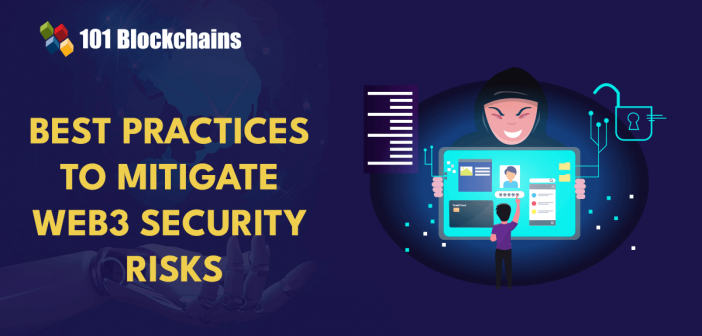The promises of innovation with web3 seem to have moved farther on the horizon. Why? Web3 has emerged as a revolutionary improvement over the existing version of the internet, which is centralized in nature. The domain of web3 relies on technologies such as blockchain, smart contracts, and cryptocurrencies to give control back to the hands of users. On the other hand, it is also important to note how web3 security risks can put users at a disadvantage for choosing web3. Why should users shift to web3 from the traditional web2 solutions? If web3 is not immune to security risks, why should users take the responsibility of controlling their data? On top of it, security risks in web3 have also led to massive losses, thereby creating doubts regarding web3 adoption. Let us find out the best practices to mitigate Web3 security risks in the following post.
Why Should You Worry about Web3 Security?
Assume that you have no interest in web3 and its working mechanisms. Why would you think about the best practices for mitigating security risks in web3? Apparently, you might be at a disadvantage in comparison to other businesses without adopting web3. How? You can learn more about the fundamental concepts of web3 and how it delivers value advantages to users and businesses for finding the answer.
As web3 adoption becomes a necessity for businesses, it is important to think of essential tools and practices for ensuring web3 security. On the other hand, a web3 security guide might seem like an unreasonable choice considering the security prowess of blockchain technology. Why should you bother about web3 security when you have the power of cryptographic security with blockchain?
Blockchain is decentralized, secure, and immutable, which means that everyone in the network can see and verify transactions. Once transactions are registered on blockchains, they cannot be changed. Most important of all, a group of participants in the network help in verifying and adding transactions to the blockchain. Therefore, it is practically impossible for a single individual to introduce malicious changes in the blockchain network.
However, blockchain itself is not immune to security risks. As a matter of fact, the best practices to mitigate web3 security risks would recommend an in-depth understanding of security risks with blockchain technology. Hackers have always improvised their approaches for attacking new systems. The introduction of blockchain technology offered them an opportunity to come up with new types of attacks.
Learn the fundamentals, challenges and use cases of Web3.0 blockchain from Web 3.0 Blockchain E-book
How Does Web3 Security Look Like Now?
The recognition of security threats in the web3 landscape proves that web3 is not an impenetrable fort. As a matter of fact, a report on the state of web3 security in 2022 has revealed some alarming insights about security risks in web3. On one hand, the cryptocurrency market has been going through a downturn, displacing almost 65% of the market capitalization.
At the same time, the web3 industry also registered a record-breaking surge in number of scams and hacks in 2022. The web3 security audit report for 2022 revealed that the total financial losses due to web3 scams and hacks amounted to $3.7 billion. Industry experts also pointed out how the losses due to web3 security threats have increased by a humongous margin. In 2021, the total losses due to web3 scams and malicious attacks amounted to almost $1.3 billion.
The review of the existing state of web3 security also draws attention to the big numbers of losses in 2022. Investors lost over $207 million to rug pulls and exit scams. On the other hand, oracle manipulation or flash loan attacks led to losses worth more than $355 million.
The Ronin Bridge hack led to a loss of $625 million, followed by the Wormhole Bridge attack, which led to $326 million in losses. Furthermore, private key thefts led to losses exceeding $1 billion in 2022. The problems in web3 security also point to the failure of big names in the space, such as the collapse of FTX exchange.
The responses to “How do I make my web3 more secure?” would also point towards the other types of attacks, such as phishing scams. Apparently, phishing scams led to a total loss of almost $108 million within the first six months of 2023. Web3 security attacks have led to losses of over $655 million in the first six months of 2023.
One of the most common and financially impactful attacks refers to smart contract vulnerabilities. As a matter of fact, smart contract vulnerabilities were responsible for the loss of $264 million. The DeFi sector suffered the brunt of security pitfalls in 2023, with around 85 security incidents leading to a loss of $292 million.
Want to explore an in-depth understanding of security threats in DeFi projects? Enroll now in the DeFi Security Fundamentals Course
Best Practices for Safeguarding Web3
The review of the existing state of web3 security shows that web3 is vulnerable to a broad range of setbacks in security. Businesses would need more than a web3 security audit to improve their web3 security infrastructure. Web3 has been expanding continuously, and its growth has led to the rise of different security challenges.
The potential of web3 has been expanding at a massive scale, thereby implying that businesses and tech experts need proactive approaches to ensuring security. Robust web3 security measures are essential for dealing with conventional issues such as social engineering and exit scams alongside emerging security risks. Let us take a look at the essential best practices for safeguarding web3 solutions against security risks.
1. Implementation of Security Governance in Web3 Projects
The best approach for dealing with security risks in web3 would involve integration of security governance in web3 projects. Organizations have to prepare for modeling, analysis, and mitigation of risks prior to and throughout the web3 development process. Developers should pay attention to the importance of earlier identification of web3 security risks, such as technical risks, operational risks, and regulatory risks.
Subsequently, developers should also invest time and effort in a comprehensive assessment of each risk to determine their likelihood and impact. Finally, organizations could use risk assessment outcomes for developing and implementing effective systems and controls for mitigating security risks.
Organizations seeking a web3 security guide must understand the importance of proactive risk identification. Rather than waiting for security incidents to happen, you need to identify the types of web3 security attacks which are more likely to influence a particular project. Therefore, you would have to pay attention to certain questions on aspects such as,
- Areas of code are most likely to be affected by web3 security attacks.
- Impact of security risks on incident response protocols.
- Reporting mechanisms for vulnerabilities.
- Approaches for managing user permissions.
- Readiness of an organization or project for community governance.
- Methods for managing major changes or forks in the chain after security breaches.
Most important of all, the inferences regarding all these aspects should align with the cybersecurity governance program of the organization.
Build your identity as a certified web3 & blockchain expert with 101 Blockchains’ Web3 & Blockchain Certifications designed to provide enhanced career prospects.
2. Rely on Security-by-Design Principles
The introduction to fundamentals of web3 security offer insights into the different ways in which hackers exploit vulnerabilities. How can you reduce the vulnerabilities? The best practices to mitigate web3 security risks would also involve designing web3 systems without vulnerabilities. Developers should follow security-centric criteria in the design and infrastructure for new web3 systems.
The first step for incorporating security by design in web3 systems involves the reduction of attack surface areas. Developers can achieve the same through secure coding practices, continuous monitoring of suspicious activity, and implementation of security controls.
You can also rely on zero-trust frameworks for supporting the security by design principles in web3 development. Zero-trust frameworks offer an effective security model which requires all users and devices to go through authentication and authorization before accessing the system. As a result, hackers could not penetrate web3 systems by compromising a specific device or user account.
The answers to “How do I make my web3 more secure?” would also point towards implementation of secure defaults. Secure default settings ensure more difficulty for hackers in exploiting vulnerabilities. Developers could establish secure defaults through a selection of systems with secure settings, preparing strong passwords, and removing unwanted features.
Another important entry among security by design principles points to separate and minimal privileges. Users would be provided with the access privileges required for performing their jobs, thereby preventing access to confidential data.
Excited to Design and develop secure blockchain systems and dApps, Enroll now in Certified Blockchain Security Expert (CBSE) Certification
3. Strategic Choice of Blockchain Design
The type of blockchain used in creating web3 systems also serves as a major influence on web3 security outcomes. Security by design principles could help you score good results in a web3 security audit for safeguarding web3 systems. On the other hand, the type of blockchain you choose for web3 projects also influences the strength of security. For example, public blockchain networks allow any individual to join with anonymity. On the contrary, private blockchain networks feature access privileges and membership conditions.
The different types of blockchains feature distinct complexities, which suggests that you have to learn about every blockchain design. You should notice that different types of blockchain infrastructures, such as sidechains, cross-chains, oracles, and federations, have unique measurements of speed, resilience, and efficiency. Therefore, you should practice caution during the selection of blockchain type while paying attention to tradeoffs between privacy and transparency.
Curious to develop an in-depth understanding of web3 application architecture? Enroll Now in the Web3 Application Development Course!
4. Independent Audit and Analysis of Web3 Code and Smart Contracts
Another entry among the best practices for safeguarding web3 systems and applications points to independent audits. The advantages of a web3 security audit are useful for developers before as well as after the code release. Regular audits are a must-have for web3 development projects, especially for startups that do not have strong security governance mechanisms.
Audits could help in faster and more accurate identification of security vulnerabilities before malicious actors can compromise them. Security audits could help in identifying effective ways to mitigate security risks and vulnerabilities with ideal methods. For example, audits can recommend the use of data wrapping or encryption techniques for safeguarding sensitive information.
If you don’t employ security audits, you are more likely to welcome web3 security risks with open arms. Failure to implement web3 audits could lead to breaches, critical errors, privacy vulnerabilities, and insider attacks. Frequent audits could help in identifying bugs in the code, which could lead to negative outcomes for projects. In addition, audits can also help you recognize the possibilities for misuse of sensitive user data.
Excited to learn about the critical vulnerabilities and security risks in smart contract development, Enroll now in the Smart Contracts Security Course!
5. Gain More Knowledge on Web3 Security
The most commendable addition among best practices for safeguarding web3 systems points to learning more about web3 security. You can use professional training courses on web3 and web3 security to understand the origins and enablers of web3 vulnerabilities. On top of it, you can use certain channels such as Github to obtain resources on web3 security.
One of the most interesting examples of an educational industry resource on web3 security is the Cryptocurrency Incident Database by OODA Loop. The database provides a detailed explanation of different cyber-attacks in web3 and their root causes. You can also refer to other platforms such as Reddit, Twitter, and Discord for learning more about web3 security.
6. Improve Fluency in Attack Prevention Techniques
The evaluation of risks due to data manipulation and information quality is an important factor for off-chain and on-chain decisions. In addition, developers must also focus on the information required for validating transactions or ownership of digital assets. You could address the important requirements for a web3 security guide by learning about the methods for dealing with common security threats.
Developers have to learn about the security risks for the UX workflow and blockchain architecture. For example, developers could avoid the risks that are specifically targeted toward blockchain architecture, like the 51% attacks. Apart from specializing in techniques for preventing attacks, developers should include security in UX design, user onboarding, and communications.
Start your journey to becoming an expert in Web3 security skills with Web3 Security Expert Career Path
Final Words
The outline of the best practices to fight against web3 security risks provides effective recommendations for improving web3 security. One of the most promising strategies for web3 security points at the ‘security by design’ principle. On top of it, you should also consider the necessity of frequent security audits for safeguarding web3 systems.
The outline of best practices to mitigate web3 security risks also emphasizes the need for professional training in web3 security. With a better understanding of how web3 works, you are more likely to understand the root causes behind web3 vulnerabilities. Learn more about web3 security and become a certified professional in web3 technologies now.
*Disclaimer: The article should not be taken as, and is not intended to provide any investment advice. Claims made in this article do not constitute investment advice and should not be taken as such. 101 Blockchains shall not be responsible for any loss sustained by any person who relies on this article. Do your own research!








